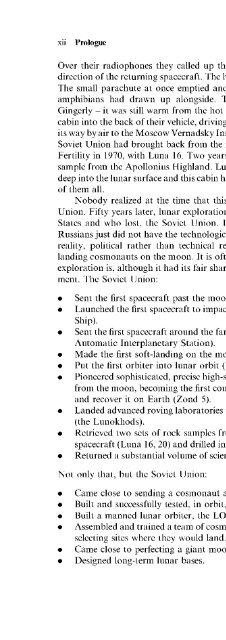Soviet and Russian Lunar Exploration
Soviet and Russian Lunar Exploration
Soviet and Russian Lunar Exploration
Create successful ePaper yourself
Turn your PDF publications into a flip-book with our unique Google optimized e-Paper software.
Over their radiophones they called up the amphibians who headed straight in the<br />
direction of the returning spacecraft. The helicopters saw the cabin reach the ground.<br />
The small parachute at once emptied <strong>and</strong> deflated to lie alongside. In minutes the<br />
amphibians had drawn up alongside. The army crews cut the parachute free.<br />
Gingerly - it was still warm from the hot fires of reentry - they lifted the blackened<br />
cabin into the back of their vehicle, driving back into Surgut. Within hours, it was on<br />
its way by air to the Moscow Vernadsky Institute. This was the third set of samples the<br />
<strong>Soviet</strong> Union had brought back from the moon. The first had come from the Sea of<br />
Fertility in 1970, with Luna 16. Two years later, Luna 20 had brought back a small<br />
sample from the Apollonius Highl<strong>and</strong>. Luna 24 had gone a stage further <strong>and</strong> drilled<br />
deep into the lunar surface <strong>and</strong> this cabin had the deepest, biggest sample of moon soil<br />
of them all.<br />
Nobody realized at the time that this was the last lunar mission of the <strong>Soviet</strong><br />
Union. Fifty years later, lunar exploration is remembered for who won, the United<br />
States <strong>and</strong> who lost, the <strong>Soviet</strong> Union. In the popular mind, the view is that the<br />
<strong>Russian</strong>s just did not have the technological capacity to send people to the moon. In<br />
reality, political rather than technical reasons prevented the <strong>Soviet</strong> Union from<br />
l<strong>and</strong>ing cosmonauts on the moon. It is often forgotten that the story of <strong>Soviet</strong> lunar<br />
exploration is, although it had its fair share of disappointments, also one of achievement.<br />
The <strong>Soviet</strong> Union:<br />
• Sent the first spacecraft past the moon (the First Cosmic Ship).<br />
• Launched the first spacecraft to impact on the lunar surface (the Second Cosmic<br />
Ship).<br />
• Sent the first spacecraft around the farside of the moon to take photographs (the<br />
Automatic Interplanetary Station).<br />
• Made the first soft-l<strong>and</strong>ing on the moon (Luna 9).<br />
• Put the first orbiter into lunar orbit (Luna 10).<br />
• Pioneered sophisticated, precise high-speed reentries into the Earth's atmosphere<br />
from the moon, becoming the first country to send a spaceship around the moon<br />
<strong>and</strong> recover it on Earth (Zond 5).<br />
• L<strong>and</strong>ed advanced roving laboratories that explored the moon for months on end<br />
(the Lunokhods).<br />
• Retrieved two sets of rock samples from the surface of the moon by automatic<br />
spacecraft (Luna 16, 20) <strong>and</strong> drilled into the surface for a core sample (Luna 24).<br />
• Returned a substantial volume of science from its lunar exploration programme.<br />
Not only that, but the <strong>Soviet</strong> Union:<br />
• Came close to sending a cosmonaut around the moon first.<br />
• Built <strong>and</strong> successfully tested, in orbit, a lunar l<strong>and</strong>er, the LK.<br />
• Built a manned lunar orbiter, the LOK.<br />
• Assembled <strong>and</strong> trained a team of cosmonauts to explore the moon's surface, even<br />
selecting sites where they would l<strong>and</strong>.<br />
• Came close to perfecting a giant moon rocket, the N-1.<br />
• Designed long-term lunar bases.







